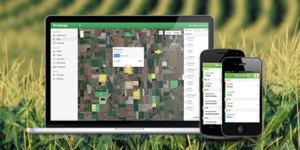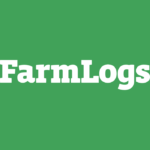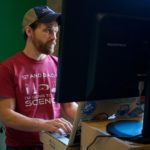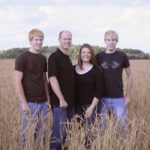
“We’re a company that’s focused on solving real problems for growers.”
| Offering |
Cloud-based Information System for Farm Management:
|
| Value Proposed to Customers |
Allow farmers to do their work more effectively — increase crop yield and operate more profitably:
|
| Sample Resources that Offering Makes More Of | i. Existing acre-level data sources (e.g., from National Weather Service, satellite imagery, more)
ii. A founder’s deep hands-on understanding of farming (CEO grew up as fifth-generation farmer), including understanding farming as a business. iii. Founders’ Computer Science knowledge and Enterprise Management knowledge iv. Technology (Cloud, Satellite, more) v. Science associated with farming (Agronomy) |
| Societal Progress | “Profit“ — benefit to U.S. economy. “People“ — for increasing population, “dramatic” increase in amount of food grown from same amount of land. “Planet“ — more sustainable use of farm land. |
1. Agents’ Path to Hypotheses
 A nagging problem …
A nagging problem …
In coming of age, a FarmLogs co-founder and its CEO, Jesse Vollmar, was “in love with technology … in love with the Internet.” At the same time, he had grown up working on his family farm. He understood farming as an enterprise, including its challenges, and he cared deeply about people engaged in it.
- In high school, Vollmar observed desktop software for farm management not functioning well (e.g., including requiring attending training to try figure out how to use it).
- In college, as he pursued love of computer science, he built a database for his family’s grain elevator. With friend (and eventual FarmLogs co-founder), Brad Koch, he formed a consulting business building custom enterprise software to help pay for college.
- “But there was this nagging problem on the periphery where I could see that all the people that I cared about … all the farmers that were around us were suffering by not having any cutting edge technology coming into their businesses.”
- Farming has benefited from major improvements in equipment and more recently from genetics. Farmers were “early adopters of technology and had even things like auto guidance on their machines twenty years ago.” But today’s farmers “are faced with the incredible challenge of increasing food production and doing it without getting any more land at all.”
- “The next wave of technology just hadn’t happened yet” for farming, but it could.
2. Hypothesis of “What Could Be” As New Value
 “The internet changes the way we can think about software and data and analytics, and none of that was happening on the farm.”
“The internet changes the way we can think about software and data and analytics, and none of that was happening on the farm.”
Internet connectivity in rural areas “has now reshaped what is possible.”
For needed “massive new efficiencies” … “data science is the next big wave of evolution on the farm.”
Sample Knowledge Connected in “What Could Be” Hypothesis:
Domain/Industry Knowledge
- A founder grew up as fifth-generation farmer, working family farm.
- Understood farming as science-based enterprise, including:
- agronomy as science and technology of producing and using plants for food, fuel, fiber, and land reclamation
- areas of risk, including overall difficulty of operating profitably
- prior waves of technology that supported farming’s yield (e.g., equipment, genetics)
- areas of major investment (e.g., a combine costs $400,000-$600,000)
- value of information to farming’s enterprise, including pertinent types of information (some farmer sourced & some public sourced) and pertinent types of information integration/analytics
- ineffective aspects of early desktop information-management offerings and of self-made spreadsheets and/or “piles of notebooks full of planting dates and seed varieties”
- for organic farming, record keeping is “key for certification”
Customer Knowledge
- Understanding farmers’ established practices (e.g., scouting fields from truck) and types of decision making.
- Understanding farmers’ history as early adopters of technology (e.g., including driverless tractors in use for years)
- Deep understanding of farming culture: “This (technology applied to farming) is a way for you to bridge the gaps between your sons and your grandsons that you want to take over the farm.” “I think that one way that (the) older generation can convince the family to step up and take over and be part of the farm is by being open minded to technology and allowing them to utilize that on their farm.”
Technology Knowledge
- Understanding farming technology’s history and status.
- Realizing that Internet connectivity in rural areas “has now reshaped what is possible.” Includes farming applications of cloud technology, satellite technology, and more.
- Experience designing & developing enterprise software.
Human-Social Knowledge
- “(If) you can put a compelling message in front of the farmer — it’s something that they know is going to make a big difference in their business and operation — they will gladly sign up as long as you enable that to be a frictionless experience.”
Other Knowledge
- Enterprise management. Cultivated initially by this focus for computer science application. Cultivated further by participation in Y Combinator program (e.g. program mantra of “Make Something People Want”).
- Data Science. Understanding how this discipline can generate new business value from data.
3. “How” the Hypothesized New Value Could Become an Offering
Some Key Elements of Business Model:
Core Value Proposition — Developing The Product
 Prototype offering generated as basis for applying to Y Combinator’s program:
Prototype offering generated as basis for applying to Y Combinator’s program:
- From the selective Silicon Valley based 3-month program, gain mentoring plus seed capital and connections in exchange for equity in each participant’s enterprise.
- Use seed money to establish initial team and ready-to-market offering.
- Make value of initial “standard” offering compelling to encourage early steep curve of user adoption. “Free, easy-to-use tools that lead to quick and sound decision-making.” For example:
- Mobile app for farmers to log field-specific information such as date & location of fertilizing, planting, spraying, etc.
- Continually updated FarmLogs input of acre-level information about rainfall, heat units, and more (real-time plus multi-year history).
- With any Internet-enabled device, view pre-designed graphic displays of information (e.g., current-year pattern of rainfall vs. prior years).
- And/or create personal integration and manipulations of the data.
- Benefits such as: input planning (“see your budget and planning”), inventory management (“monitor movement of crops from field to storage to buyer), estimates of crop growth and maturity, and more.
Revenue Source — Tiered Pricing (Free “standard” level of offering)
 Fee-based services added to the still-free “Standard” product:
Fee-based services added to the still-free “Standard” product:
- Given customer penetration, develop more advanced fee-based services. “Catch yield threats sooner, minimize uncertainty, and increase your margins.”
- Stay on top of this strategy via self-disciplined expeditious product development.
Sample fee-based product features draw on additional technology (e.g., satellite imagery, Internet of Things) to incorporate greater automation for data input (e.g., machine-based log of certain type of “notes”) and analytics geared to actionable insights and increasing precision (e.g., generating alerts, recommendations, etc.). For example:
- Hardware device (with built-in modem) to be plugged into combines and/or tractors for automated collection of field-specific data, to be integrated with other field-level data sources (e.g., from farmers’ hand and/or automated logging, satellite imagery, weather data).
- Nitrogen monitoring: where a model determines nitrogen losses and mineralization gains, based on acre-level data such as daily weather, soil parameters, plant population, and relative maturity, and generates an application rate recommendation.
- Crop health monitoring: “Five years of historical measurements are used to create performance baselines for every five square meters of your fields. The health of the crop is then monitored in-season against this baseline to detect anomalies. When an area of your field looks different from how it normally would, FarmLogs creates an alert for that field and shows the exact location that needs to be investigated.” The web site notes an example of grasshopper infestation that was detected in time to address it.
- Data science models provide even more precise actionable insights (e.g., to both optimize and automate the farmer’s applications of seed and nitrogen throughout a field). For making increasingly large difference in crop yield and profitability.
Key Partners —
For example, a partner source of satellite imagery at per-acre level, including imagery archive of 10-year history, makes greater (and compensated) use of the partner’s imagery as it adds value to the FarmLogs offering. Win-win within the business model.
- See this FarmLogs blog post for an example of incorporating this type of partner, within context of the strategic expeditious approach to developing new product features.
- A steady flow of “how” hypotheses features continuing connections of pertinent knowledge among multiple specialized FarmLogs practitioners.
Customer Relationships —
Provide a “frictionless” user experience:
- “Intuitive” app interface
- Dedicated team for user support in addition to video tutorials.
Promote connection with farmers and farming community:
- Business located in Michigan, within one day’s drive of every U.S. “Corn Belt” location .
- Annual User Conference.
 Road Show throughout U.S. during nine summer days in 2016 (devoted to events with food and community sharing).
Road Show throughout U.S. during nine summer days in 2016 (devoted to events with food and community sharing).
Co-creating next-level FarmLogs product features?
Description of Road Show suggests a potentially increasing strategy of co-creation of the the FarmLogs suite of services: It includes calls for farmers playing a role in the FarmLogs mission:
- “To hear your stories about tech on the farm …”
- “Listen to FarmLogs CEO Jesse Vollmar talk about his family farm, why he founded FarmLogs, and the important role today’s farmers play in the company’s mission.”
- “Learn how you can get involved in the company’s mission to help shape the future of farming.”
If the farmers’ role in the mission means that newly envisioned FarmLogs product services make more of data science (e.g., for “massive efficiencies” for farmers), this may in turn mean that models incorporate (and rely on) an aggregation of data generated from individual farmers and their fields. This could introduce sensitivities, calling for fitting and effective “how” hypotheses for customer relations. For example, it’s possible that a Road Show (or other approach) would begin to paint a picture of possibilities and propose a compelling approach to co-creation.
4. Value to the FarmLogs Agents
The combination of a purpose that’s larger than the self but personally compelling, with an equally compelling idea for making a difference — a “what could be” hypothesis grounded in pertinent knowledge.
 Vollmar commenting on FarmLogs’ rapid growth — as of fall 2015, one in three U.S. farms was using Farm Logs, plus on every continent but Antarctica: “That’s really exciting, and it just comes from solving real problems for them — giving them access to information that they can’t get anywhere else.”
Vollmar commenting on FarmLogs’ rapid growth — as of fall 2015, one in three U.S. farms was using Farm Logs, plus on every continent but Antarctica: “That’s really exciting, and it just comes from solving real problems for them — giving them access to information that they can’t get anywhere else.”
“We believe in creating a better future for farming.”
For now,” working on FarmLogs “is the way for me to make the biggest impact on the farming community.”
SOURCES:
- www.FarmLogs.com
- https://techcrunch.com/2015/09/22/one-in-three-farms-are-using-farmlogs-to-power-their-yields-with-big-data/
- https://vimeo.com/119579532
- https://techcrunch.com/2014/09/05/farming-startup-farmlogs-triples-marketshare-in-last-six-months/
- http://modernfarmer.com/2014/03/farm-app-harvests-big-data/
- http://www.forbes.com/sites/amitchowdhry/2013/02/14/farmlogs-is-going-to-change-the-way-farmers-manage-their-business/#4a7674c0387chttp://
- www.inc.com/christina-desmarais/farmlogs-y-combinator-start-up-alum-disrupting-farming.html
- https://news.ycombinator.com/item?id=9030832